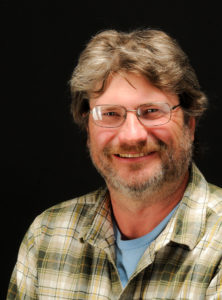
Michael Petronis, geology professor
Las Vegas, N.M. – A powerful new geology research instrument at Highlands University will open up opportunities for students in research that will advance knowledge in dormant and active volcanoes, continental plate movements and ancient climate change, with implications for modern climate change.
Thanks to a $523,844 grant from the National Science Foundation, Highlands will add a superconducting rock magnetometer to its state-of-the-art Paleomagnetic – Rock Magnetic Laboratory, the only research lab of its kind in New Mexico, Eastern Arizona and Southern Colorado.
“This exciting new tool gives us the capability to pursue new studies related to the motion of the continental plates, called tectonics, which can help predict earthquake recurrence patterns,” said Highlands geology professor Michael Petronis. “We can expand our volcanology studies that shed light on the growth of ancient volcanoes here in New Mexico as well as international locations such as the Czech Republic. This new knowledge has implications for better understanding active volcanoes worldwide.”
Petronis said paleomagnetism studies the history of the earth’s magnetic fields recorded in rocks, with another important application being pressing environmental concerns like climate change.
“This cutting-edge instrument allows us to measure extremely weak magnetic fields at the microscopic nanomaterial level,” Petronis said. “It’s also more than a thousand times more sensitive than the magnetometer that measures magnetic fields in our existing lab, and is also fully automated – allowing for dramatically faster analysis of a broader variety of samples.”
Since 2008, the NSF has awarded more than $1.5 million in grants for the Highlands Paleomagnetic – Rock Magnetic Laboratory, which Petronis directs. He also wrote some of the grants and co-wrote others with fellow geology professor Jennifer Lindline.
The newest tool in the lab’s arsenal is a cylinder-shaped magnetic shield with a measurement chamber cooled to superconducting temperatures of minus 450 degrees Fahrenheit – minus 269 Celsius – which allows for measurement of extremely weak magnetic fields.
“This new instrument in our paleomagnetic lab makes our geologic facilities on par with institutions like Cal Tech, MIT, Yale and Berkeley,” Petronis said.
He said Highlands is offering its students world-class research opportunities in the paleomagnetic lab that help prepare them for advanced academic studies and high-paying careers in the geoscience field.
“The research our geology students conduct is transformative in their development as geoscientists. It has also helped them land positions with employers like Los Alamos National Laboratory, NASA, the Office of the State Engineer and environmental consulting firms,” Petronis said.
He said the new instrumentation will also help advance his ongoing snowball earth hypothesis research. Petronis is part of an international team of scientists that is studying the Norwegian High Arctic, finding that the earth wasn’t frozen from pole to pole in ancient geologic times as previously thought, giving scientists a better understanding of global climate change on a planetary scale.
Since 2009, Petronis and his students have used the paleomagnetic lab for 31 research studies published in scholarly journals such as the Journal of Geophysical Research, Nature and Bulletin of Volcanology. Petronis and Lindline’s students were lead authors on 15 of these studies.
The Highlands paleomagnetic lab research to date has also generated more than 80 conference abstracts, most authored by students.
Petronis said another benefit of Highlands University’s paleomagnetic research capacity is the national and international research collaboration it fosters.
“We are already collaborating with the University of North Carolina, University of New Mexico, New Mexico State University, Northern Arizona University, Sul Ross State University, Kent State University and Kansas Geological Survey, as well as several European universities. With the acquisition of this new instrument, I expect more research partnerships. These partnerships raise the profile of Highlands in the global geologic research community and build our students’ global competency,” Petronis said.
Other funding sources for some of the instruments and student research opportunities in the Paleomagnetic – Rock Magnetic Laboratory at Highlands include a $300,000 grant from the USDA as well as approximately $100,000 from the National Geographic Society and Highlands University research funds.
